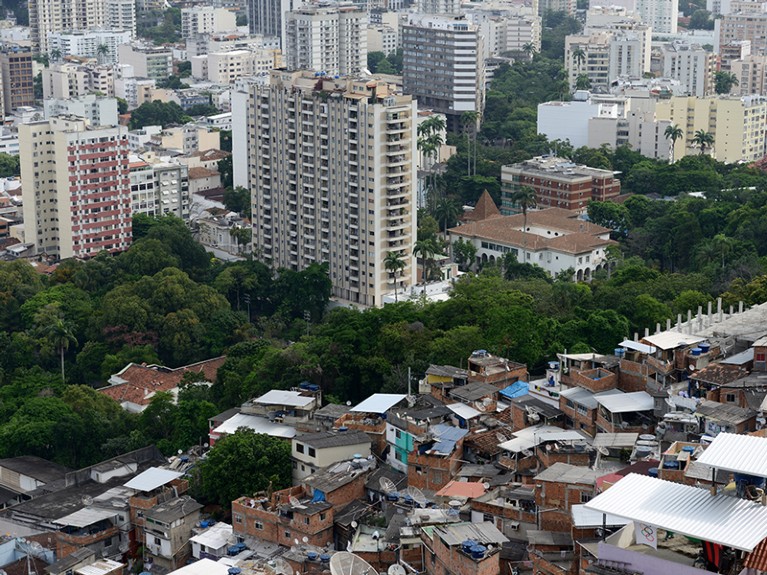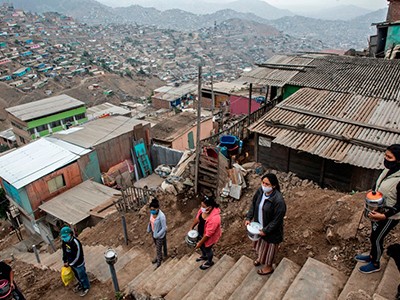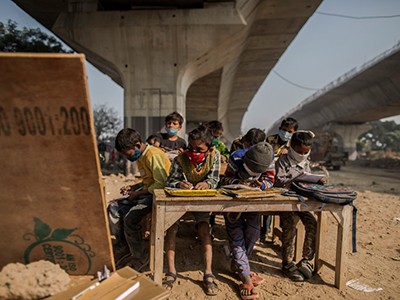
A tale of two cities: an aerial view of Rio de Janeiro in Brazil illustrates the scale of inequality. Research shows that, within nations, the income gap between the richest and poorest is increasingCredit: Frédéric Soltan/Corbis/Getty
Last month, researchers from 67 nations wrote an open letter to United Nations secretary-general António Guterres and World Bank president Ajay Banga, urging them to “redouble efforts to address rising extreme inequality”. The move was motivated, in part, by the lack of progress on the 10th of the 17 UN Sustainable Development Goals (SDGs). Nature is examining each goal in a series of editorials.
The aim of SDG 10 is to “reduce inequality within and among countries”. That means narrowing the difference between the incomes of the richest and the poorest, on both a national and an international level. The goal also proposes ensuring equality of opportunity. Unfortunately, the world is clearly failing to meet SDG 10. The letter’s authors go further, saying that the goal is being “largely ignored”.
How COVID has deepened inequality — in six stark graphics
This is not the first time that researchers have tried to focus the world’s attention on inequality. For a better chance of success, the letter’s authors should study what happened to previous efforts — in particular, the 2009 publication of the influential text The Spirit Level by epidemiologists Richard Wilkinson and Kate Pickett. They showed that reducing inequality has a cascade of benefits, from better health to lower crime rates and better educational outcomes.
The book was a sensation. It was read avidly and quoted widely; its findings referenced by David Cameron, later UK prime minister, and Christine Lagarde, now president of the European Central Bank, among others. Yet despite being widely respected, the authors’ careful synthesis of evidence on the benefits of equality — and subsequent invites to give talks and policy advice worldwide — did not change governments’ approaches to inequality.
Not all of the targets for SDG 10 are failing. Overall income inequality between countries is dropping. Another target, to reduce the costs incurred by migrant workers sending remittances to their families, is also on its way to being met — although not by the SDGs’ 2030 deadline.

Richard Wilkinson and Kate Pickett, the authors of the book The Spirit Level: Why Equality is Better for Everyone.Credit: Alex Holland
But income inequality within countries is rising, as measured by the Gini index, a measure of income distribution across a population. Globally, in the 15 years to 2019, economic output in terms of gross domestic product (GDP) roughly doubled, but the share of economic output earned by the workers producing the goods and services behind the increase fell from 54.1% in 2004 to 52.6% in 2019.
So what has gone wrong? Between 2019 and 2020, the COVID-19 pandemic caused the steepest rise in global inequality since the Second World War. Some people couldn’t go to work or saw their jobs furloughed, whereas others — mostly in higher-level jobs — were able to move their work online, says Ida Kubiszewski, an ecological economist at University College London.
Then inflation rose. The global average for 2021 was 4.7%, but the rate was much higher in many low- and middle-income countries (LMICs). And that was before Russia’s invasion of Ukraine in February 2022. Although many higher-income countries increased social protections for the most vulnerable, lower-income countries found it a struggle to do so. The aid group Oxfam and the non-profit organization Development Finance International have created an index that measures what governments are doing to tackle inequality. The 2022 edition assessed 161 governments between 2020 and 2022. It found that, during this period, 70% of governments cut their share of spending on education and two-thirds failed to increase the minimum wage in line with GDP (see go.nature.com/3ywfbif). Some high-income nations are also reducing their development assistance, and direct investment in LMICs by foreign countries is also falling, data from the World Bank show.
Tackling inequality takes social reform
Researchers say that progress on SDG 10 would have been dismal even without the pandemic and the invasion of Ukraine. A large part of the problem is that each of the 17 SDGs has tended to be pursued in isolation, with policymakers unaware that reducing inequality would benefit many of the other goals. A 2019 network analysis studying interactions between SDGs found that reducing inequality in wealthy nations would help to achieve almost all of the other goals (D. Lusseau & F. Mancini Nature Sustain. 2, 242–247; 2019). The same is true of reducing poverty in poorer nations. This brings us back to last month’s open letter and the arguments made in The Spirit Level. Reducing inequality involves up-front increases in expenditure in areas including health care, social protection and education.
The letter calls for Guterres and Banga to “back vital new strategic goals and indicators”. Among other factors, its authors say, significant improvements in the data on inequality, especially on estimates of top incomes, should make it possible to better understand how policy changes could influence the divide between rich and poor.
Better data are essential, and the lack of good data to support work on the SDGs is becoming something of a theme in this editorials series. But better data alone will not reduce inequality, Wilkinson points out. Asked why he thinks SDG 10 is failing, he points to a reduction in inequality that occurred in high-income nations from the 1930s until the end of the 1970s, broadly because social movements challenged the state to play a bigger part in protecting vulnerable people. He thinks something like that will need to happen again. “Given the powerful interests involved,” he says. “I don’t know why anyone thought that a statement of goals such as the SDGs would succeed.”
Researchers are right to urge leaders to prioritize inequality. They would do even better to study the efforts of Pickett, Wilkinson and others, and determine the reasons why these did not bear fruit.

 How COVID has deepened inequality — in six stark graphics
How COVID has deepened inequality — in six stark graphics
 The rise of inequality research: can spanning disciplines help tackle injustice?
The rise of inequality research: can spanning disciplines help tackle injustice?
 Tackling inequality takes social reform
Tackling inequality takes social reform
 These experiments could lift millions out of dire poverty
These experiments could lift millions out of dire poverty
 Equity must be baked into randomized controlled trials
Equity must be baked into randomized controlled trials






